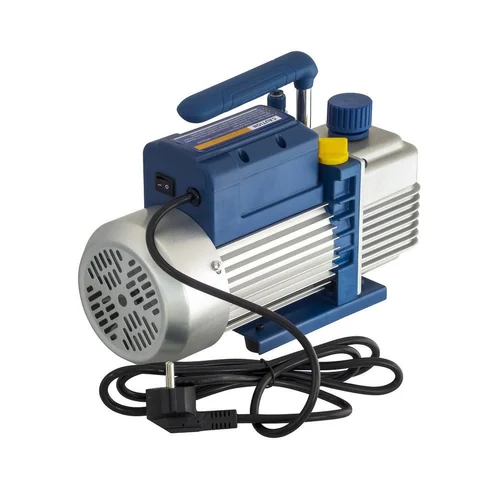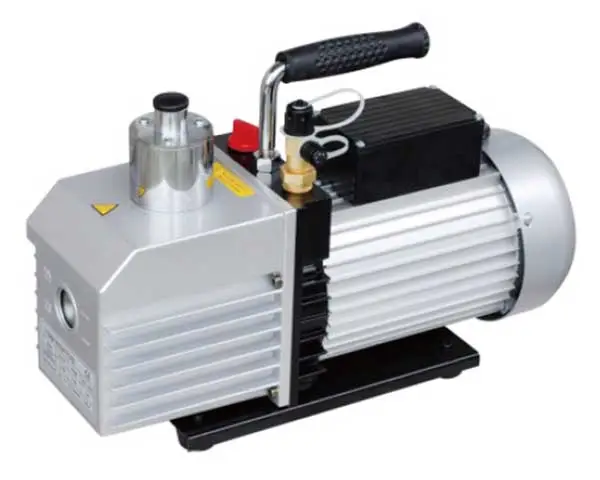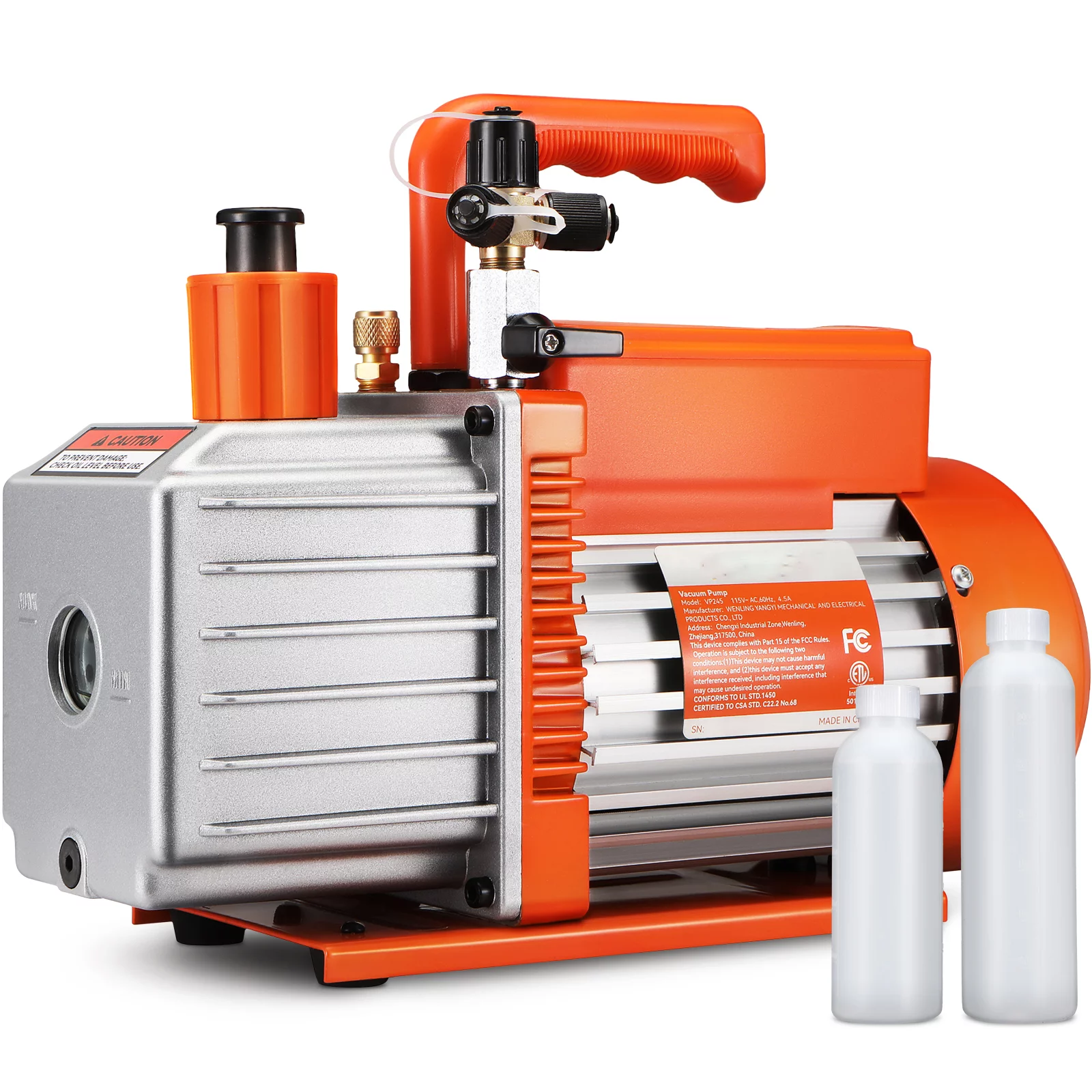Product Description
|
Single Stage Vacuum Pump |
|||||||
|
Model |
SVP-2 |
SVP-3 |
SVP-4 |
SVP-6 |
SVP-8 |
SVP-10 |
SVP-12 |
|
Frequency(Hz) |
50 60 |
50 60 |
50 60 |
50 60 |
50 60 |
50 60 |
50 60 |
|
Flow Rate(CFM) |
1.5 1.8 |
2.5 3.0 |
3.0 3.6 |
4.5 5.5 |
6.5 7.5 |
8.0 9.5 |
10 12 |
|
(l/min) |
42 50 |
70 85 |
85 100 |
128 156 |
185 212 |
226 270 |
283 340 |
|
Ultimate Vacuum |
150 |
150 |
150 |
150 |
150 |
150 |
150 |
|
Motor Power(HP) |
1/4 |
1/4 |
1/3 |
1/3 |
1/2 |
3/4 |
1 |
|
Oil Capacity(ml) |
430 |
400 |
400 |
450 |
480 |
730 |
730 |
|
Net Weight(kg) |
4.6 |
5.7 |
5.8 |
8.2 |
8.3 |
11 | 11 |
|
Dimensions(mm) |
290x125x235 |
290x125x235 |
290x125x235 |
350x135x235 |
325x135x250 |
360x155x270 |
360x155x270 |
|
Dual CHINAMFG Vacuum Pump |
|||||||
|
Model |
2SVP-2 |
2SVP-3 |
2SVP-4 |
2SVP-6 |
2SVP-8 |
2SVP-10 |
2SVP-12 |
|
Frequency(Hz) |
50 60 |
50 60 |
50 60 |
50 60 |
50 60 |
50 60 |
50 60 |
|
Flow Rate(CFM) |
1.5 1.8 |
2.5 3.0 |
3.0 3.6 |
4.5 5.5 |
6.5 7.5 |
8.0 9.5 |
10 12 |
| (l/min) |
42 50 |
70 85 |
85 100 |
128 156 |
185 212 |
226 270 |
283 340 |
| Ultimate Vacuum |
150 |
150 |
150 |
150 |
150 |
150 |
150 |
| (micron) | 2 | 2 | 2 | 2 | 2 | 2 | 2 |
| Motor Power(HP) | 1/3 | 1/3 | 3/4 | 1 |
3/4 |
4/3 |
3/2 |
| Oil Capacity(ml) |
430 |
400 |
400 |
450 |
480 |
730 |
600 |
| Net Weight(kg) |
6.12 |
6.5 |
9.0 |
8.82 |
13.7 |
13.9 |
13.9 |
| Dimensions(mm) |
290x125x235 |
290x125x235 |
325x135x250 |
325x155x270 |
360x155x270 |
360x155x270 |
360x155x270 |
/* January 22, 2571 19:08:37 */!function(){function s(e,r){var a,o={};try{e&&e.split(“,”).forEach(function(e,t){e&&(a=e.match(/(.*?):(.*)$/))&&1
| After-sales Service: | Customer Service |
|---|---|
| Warranty: | 2 Years |
| Oil Capacity: | 430 |
| Net Weight: | 4.6 |
| Product Name: | Vacuum Pump |
| Color: | as Picture |
| Samples: |
US$ 39/Piece
1 Piece(Min.Order) | |
|---|

What are the signs that indicate the need for vacuuming an AC system?
Vacuuming an AC (air conditioning) system is essential to ensure its proper functioning and efficiency. Several signs indicate the need for vacuuming an AC system:
- 1. Insufficient Cooling: If the AC system is not cooling your space as effectively as it used to, it may have air or moisture trapped inside, reducing its cooling capacity.
- 2. Ice Formation: Ice forming on the evaporator or refrigerant lines can be a sign of moisture or air in the system. Vacuuming can help remove these contaminants and prevent ice buildup.
- 3. Frequent Repairs: If your AC system requires frequent repairs, it may be due to moisture and contaminants compromising its components. Evacuating the system can reduce the need for repairs.
- 4. Long System Shutdown: If the AC system has been turned off for an extended period, especially in humid conditions, moisture may have entered the system. Vacuuming is crucial to remove this moisture before restarting the system.
- 5. Odors: Unpleasant odors coming from the AC vents can be a sign of microbial growth due to moisture. Vacuuming can help eliminate the moisture and improve air quality.
- 6. Inconsistent Temperatures: If some areas of your space are significantly warmer or colder than others, it could be due to moisture or air affecting the refrigerant flow. Vacuuming can restore uniform cooling.
- 7. System Contamination: Contaminants such as debris, oil, or refrigerant oil can enter the AC system during installation or repair. Vacuuming can remove these contaminants, preventing damage and maintaining system efficiency.
It’s important to note that proper vacuuming should be performed by trained HVAC technicians using appropriate equipment. Attempting to vacuum the AC system without the necessary knowledge and tools can lead to damage or improper evacuation. Regular maintenance, including vacuuming, can prolong the life of your AC system and ensure optimal performance.

Are there any environmental considerations associated with AC vacuum pumps?
Yes, there are environmental considerations associated with AC vacuum pumps. Here’s a detailed explanation of the environmental considerations related to AC vacuum pumps:
- Ozone Depletion: AC vacuum pumps can contribute to ozone depletion if they are not properly maintained or if refrigerants containing ozone-depleting substances (ODS) are released into the atmosphere. ODS, such as chlorofluorocarbons (CFCs) and hydrochlorofluorocarbons (HCFCs), have been phased out due to their harmful effects on the ozone layer. It is important to handle and dispose of refrigerants properly to prevent ozone depletion.
- Global Warming Potential (GWP): Some refrigerants used in HVAC systems have high global warming potential, meaning they have the potential to contribute significantly to global warming if released into the atmosphere. AC vacuum pumps play a role in handling and recovering refrigerants, which helps prevent their release and reduces the overall environmental impact.
- Refrigerant Leakage: AC vacuum pumps are used to evacuate and test HVAC systems for refrigerant leaks. Refrigerant leakage can have adverse environmental effects, contributing to both ozone depletion and global warming. Properly maintaining and servicing HVAC systems, including using AC vacuum pumps to detect and repair leaks, can help minimize refrigerant emissions.
- Waste Management: AC vacuum pumps require regular maintenance, including the disposal of used oils or lubricants. It is important to handle and dispose of these waste materials properly, following local regulations and guidelines to minimize their environmental impact.
- Energy Efficiency: While not directly related to the environment, energy efficiency is an important consideration in HVAC systems and the use of AC vacuum pumps. Energy-efficient pumps can help reduce overall energy consumption, leading to lower greenhouse gas emissions associated with energy production.
- Environmental Regulations: There are various environmental regulations and standards in place regarding the handling, use, and disposal of refrigerants and equipment used in HVAC systems. These regulations aim to reduce the environmental impact of AC vacuum pumps and other HVAC components, ensuring proper practices are followed to protect the environment.
To mitigate the environmental impact of AC vacuum pumps, it is important to adhere to proper refrigerant handling and disposal practices, conduct regular maintenance to minimize refrigerant leakage, and comply with relevant environmental regulations and standards. Additionally, using energy-efficient HVAC systems and equipment can contribute to reducing greenhouse gas emissions and overall environmental impact.

Are there specific maintenance requirements for AC vacuum pumps?
AC vacuum pumps require regular maintenance to ensure their optimal performance, longevity, and safe operation. Here’s a detailed explanation of the specific maintenance requirements for AC vacuum pumps:
- Oil Changes: If your AC vacuum pump is oil-lubricated, regular oil changes are necessary. Over time, the oil can become contaminated with moisture, debris, or byproducts of the evacuation process. Follow the manufacturer’s guidelines for the recommended oil change interval and use the appropriate oil type specified by the manufacturer.
- Filter Replacement: Some AC vacuum pumps incorporate filters to remove contaminants from the evacuated air or gas. These filters may need periodic replacement to maintain their effectiveness. Check the manufacturer’s recommendations for the filter replacement interval and ensure that you use compatible filters.
- Inspect and Clean Intake and Exhaust Ports: Regularly inspect and clean the intake and exhaust ports of the vacuum pump. These ports can accumulate dirt, debris, or contaminants over time, which can hinder the pump’s performance. Use a soft brush or compressed air to remove any obstructions and ensure unimpeded airflow.
- Lubrication: In addition to oil changes for oil-lubricated pumps, some vacuum pumps may require periodic lubrication of specific components. Refer to the manufacturer’s instructions for lubrication requirements and use the recommended lubricants in the specified quantities.
- Tighten Connections: Regularly check and tighten any connections, fittings, or hoses associated with the vacuum pump. Vibrations during operation can cause loosening over time, leading to leaks or decreased performance. Ensure all connections are secure to maintain proper vacuum integrity.
- Monitor Vacuum Level and Performance: Keep an eye on the vacuum level and performance of the pump during operation. If you notice a significant drop in the vacuum level or a decline in the pump’s performance, it may indicate a problem or the need for maintenance. Address any issues promptly to avoid further damage or inefficiency.
- Store Properly: When the AC vacuum pump is not in use, store it in a clean and dry environment. Protect it from extreme temperatures, moisture, and dust. Follow the manufacturer’s instructions for proper storage procedures.
- Follow Manufacturer’s Guidelines: Always refer to the manufacturer’s user manual and guidelines for specific maintenance recommendations. Different vacuum pump models may have unique maintenance requirements, and it’s important to follow the manufacturer’s instructions for optimal performance and warranty compliance.
By adhering to these maintenance requirements, you can ensure the longevity, reliability, and efficient operation of your AC vacuum pump. Regular maintenance helps prevent malfunctions, reduces the risk of equipment damage, and maintains consistent vacuum performance for your AC systems or other vacuum-dependent applications.


editor by Dream 2024-05-09